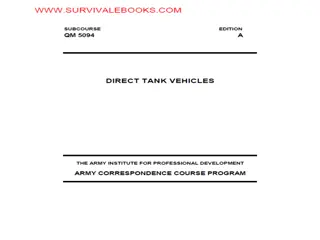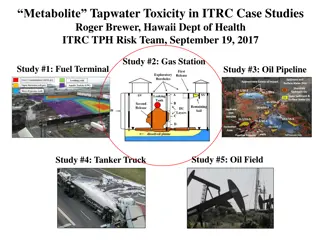Understanding Evaporation in Chemical and Petroleum Industries
Evaporation is a process of vaporizing a solvent to produce concentrated solutions used in various industries like sugar, salt, and chemical production. This article covers the principles, purposes, and types of evaporators used in the field. It explains single and multiple effect operation methods, focusing on energy efficiency and production optimization.
Download Presentation

Please find below an Image/Link to download the presentation.
The content on the website is provided AS IS for your information and personal use only. It may not be sold, licensed, or shared on other websites without obtaining consent from the author. Download presentation by click this link. If you encounter any issues during the download, it is possible that the publisher has removed the file from their server.
E N D
Presentation Transcript
Unit operation (I) Unit operation (I) Department of Chemical and Petroleum Industries Engineering Fourth Year AL-Mustaqbal University Collage Lecture (6) Evaporation (1) 1
Evaporation Evaporation Evaporation is Vaporizing a portion of the solvent (mostly water) to produce a concentrated solution of thick liquor commonly used to concentrate sugar, sodium chloride, sodium hydroxide, glycerol, glue, milk, occasionally used to produce pure water (from sea water). Evaporation Occurs at any temperature above melting point Occurs at surface of liquid Heat is generally added from top Only molecules with high kinetic energy participate Slow process Does not involve formation of bubbles Boiling Occurs at boiling point Occurs throughout liquid Heat is generally added from bottom Rapid process Involves formation of bubbles 2
Purposes of Evaporation Purposes of Evaporation Concentrate liquid foods Energy savings in subsequent operations (eg. spray drying) Reduces weight (and volume) Energy savings in storage and transportation Reduces water activity Changes flavor and/or color Types of evaporators: Types of evaporators: long vertical evaporators a) Rising-film b)Falling-film c) Rising/falling-film d)Forced circulation Agitated (or mechanical) film evaporators 3
Types of evaporators: Types of evaporators: 4
Single and multiple effect operation Single and multiple effect operation Most evaporators are heated by steam condensing on metal tubes. The material to be evaporated flows inside the tubes. Usually the steam is at low pressure, below 3 atm abs; and the boiling liquid is under moderate vacuum, at pressure down to 0.05 atm abs. Reducing the boiling temperature of the liquid increases the difference between steam and the boiling liquid and thus increases the heat transfer rate in the evaporator. When a single evaporator is used, the vapour from the boiling liquid is condensed and discarded. This method is called single effect evaporation, and it utilizes steam ineffectively. To evaporate 1 kg of water from solution needs 1 to 3 kg of steam. If the vapour from one evaporator is fed into a second evaporator and the vapour from the second is then sent to a condenser, the operation becomes double effect. The heat in the original steam is reused in the second effect, and the evaporation achieved by a unit mass of steam fed to the first effect is approximately doubled. Additional effects can be added in the same manner. The general method of increasing the evaporation per kilogram of steam by using series of evaporators is called multiple effect evaporation. Steam inside the tubes and the solution outside the tubes. This type of unit is suitable only for low-viscosity solutions that do not deposit scale on the heat-transfer surfaces. 5
Performance Performance of of tubular tubular evaporators evaporators The measure of the performance of steam heated tubular evaporator are the capacity and the economy. Capacity is defined as the number of kilograms of water vaporized per hour. Economy is the number of kilograms vaporized per kilogram of steam fed to the unit. In the single effect evaporator the economy is nearly always less than 1, but in multi effect evaporator it may be grater. The steam consumption in kilogram per hour, is also important. It equals the capacity divided by the economy. Basic Evaporator Construction: Basic Evaporator Construction: Industrial evaporator systems normally consist of: 1. A heat exchanger to supply sensible heat and latent heat of evaporation to the feed. 2. A separator in which the vapour is separated from the concentrated liquid phase. 3. A condenser to effect condensation of the vapour and its removal from the system. 6
Boiling Point Rise: The vapour pressure of aqueous solution is less than that of water at the same temperature. Consequently, for a given pressure the boiling point of the solution is higher than that of pure water. the increase in boiling point of solution over that of pure water at a given pressure is known as boiling point rise B.P.R. For a given pressure in the vapor space of an evaporator, the boiling temperature of an aqueous solution will be equal to that of pure water if the solute is not dissolved but consists of small, insoluble, colloidal material. If the solute is soluble, the boiling temperature will be greater than that of pure water. B.P.R. It is small for dilute solutions and solutions of organic colloids but may be large as 80oC (144 F) for concentrated solutions of organic salts. The BPE must be subtracted from the temperature drop that is predicted from the steam tables. 7
Method of operation of evaporator: Method of operation of evaporator: 1) Single stage or single effect of evaporator 8
Ex.1: Apple juice is being concentrated in a natural circulation single effect evaporator. At steady state conditions, dilute juice is the feed introduced at a rate of 0.67 kg.s-1. The concentration of the dilute juice is 11% total solids. The juice is concentrated to 75% total solids. The specific heats of dilute apple juice and concentrate are 3.9 and 2.3 kJ/kg.0C, respectively. The steam pressure is measured to be 304.42 kPa. The inlet feed temperature is 43.30C. The product inside the evaporator boils at 62.20C. The overall heat transfer coefficient is assumed to be 943 W.m-2.0C-1. Assume negligible boiling point elevation. Calculate the mass flow rate of concentrated product, steam requirements, steam economy, and the heat transfer area. 9
Solution : Given: mf= 0.67 kg.s-1 , xf= 0.11, xp= 0.75 , Steam pressure = 304.42 kPa, Tf= 43.3 C, Boiling temperature T1in evaporator = 62.2 C,. U = 943 W.m-2.K-1, cpf= 3.9 kJ.kg-1. C-1 cpp= 2.3 kj.kg-1. C-1 Overall mass balance: F = P + V .(1) Mass balance on solute: Fxf= P xp From Eq.2 0.11 0.67 kg.s-1= 0.75 P (2) P = 0.098 kg.s-1 Thus according to Eq. 1 mass flow rate of concentrated product is 0.098 kg.s-1and mass flow rate of vapor is 0.57 kg.s-1 Heat balance: Need to solve following enthalpy balance FHf+ SHs= VHv+ PHp+ SHc........(3) OR FHf+ S s= VHv+ PHp ( s = Hs HC) 10
Determine Hfand Hpas follows: Hf= cp T = 3.9 (43.3 -0) = 168.9 kJ.kg-1 Hp= 2.3 (62.2 - 0) = 143.1 kJ.kg-1 From steam table: Temperature of steam at 304.42 kPa = 134 C Enthalpy for saturated steam vapor Hs(Ts= 134 C) = 2725.9 kJ.kg-1 Enthalpy for saturated liquid Hc(Tc= 134 C) = 563.41 kJ.kg-1 Enthalpy for saturated vapor Hv(Tv= 62.2 C) = 2613.4 kJ.kg-1 Substitute the above values in Eq. 3 (0.67 168.9) + (S 2725.9) = (0.57 2613.4) + (0.098 143.1) + (S 563.41) 2162.49 S = 1390.5 S = 0.64 kg.s-1 Steam economy: Use V / S = 0.57 / 0.64 = 0.89 kg water evaporated / kg steam Surface area of heat exchanger: Use q = UA (Ts Tp) = S.Hs - S.Hc= S A 943 (134 - 62.2) = 0.64 (2725.9 - 563.14) 1000 A = 20.4 m2 11























